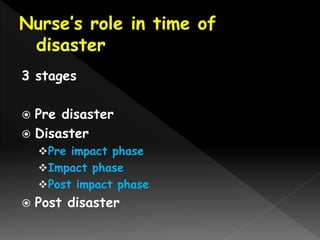Role of nurse in disaster preparedness Prof. Dr. Maheswari Ganesan
- 1. Prof.A.Arvin Babu, M.Sc (N)., PhD.N
- 3. An occurrence resulting such an extra ordinary measure of damage and the consequences cannot be dealt with by existing infra structural, technical and emergency medical services there by requiring additional assistance from outside
- 4. D - Destructions I - Incidents S - Sufferings A - Administrative, Financial Failures. S - Sentiments T - Tragedies E - Eruption of Communicable diseases. R - Research programme and its implementation
- 5. Impact of natural disaster in the last 30 years. ’é× Death of 3 million people ’é× Economic loss increased due to disaster like flood ’é× In Indian scenario, 34 million people affected per year and 5116 death per year.
- 6. NurseŌĆÖs role in disaster The nurseŌĆÖs role in disaster is not only in managing the people with health problems after disaster, also involving in the disaster preparedness
- 7. Nurse - is an active member in needs preparation ’üČ Professional preparation ’üČ Disaster preparedness ’üČ Pre disaster phase ’üČ Disaster phase ’üČ Post disaster phase
- 8. ’é× The nurse who are adequately prepared for disaster management should act as a nurse leader ’é× Others towards smoother recovery phase
- 9. Personal items recommended for nurses to help in disaster including ’é× Copy of professional license ’é× Cash ’é× Personal equipment such as stethoscope ’é× Flash light and extra batteries ’é× Weather appropriate cloths Eg. Blanket ’é× Record keeping materials ’é× Pocket size reference books
- 10. ’é× Disaster Risk assessment and ’é× Multi-disciplinary management strategies at all system levels (short, medium, and long-term health needs), but it is critical to the delivery of effective responses to the short, medium, and long-term health needs of a disaster-stricken population. International Council of Nurses (2006)
- 11. Administrative role ŌĆō the nurse should prepare the ’é× List of key personnel (Head of the rescue teams, police, voluntary health agencies) ’é× Notification procedure through media ’é× Disaster Organizational Chart (whom to report, whom to communicate)
- 12. Administrative role ŌĆō prepare for the ’é× Training of volunteers (Eg. students) ’é× Orientation Programme to risky areas ’é× Training programme for health care professionals
- 13. Administrative role ŌĆō prepare for the ’é× Maintain the of list of materials needed (Eg.medicines, certificates, license to practice) ’é× Have all information related to hospitals(Eg. Phone No) ’é× Efficient communication link between triage team and hospital
- 14. 3 stages ’é× Pre disaster ’é× Disaster ’üČPre impact phase ’üČImpact phase ’üČPost impact phase ’é× Post disaster
- 15. PRE DISASTER PHASE The nurse must involve in Advance planning Community participation Mock drill Mass education
- 16. PRE IMPACT PHASE -Safety measures -Time factor -Co-ordination
- 17. IMPACT PHASE ’é× Comprehensive Management ’é× Assess priority ’é× Identify specific needs ’é× Provide psychological support ’é× Help in early relief ’é× Rehabilitation ’é× Reconstruction
- 18. ’é× First Aid & Medical Care ’é× Life saving Resuscitation ’é× Allay Panic ’é× Avoid convergence behavior ’é× Immediate rescue and relief ’é× Professional Identification ’é× Direct people to shelters
- 19. ’é× Gather information rapidly ’é× Documentation ’é× Assess number of Casualty Inflow ’é× Arrange drugs and IV fluids ’é× Assess Adequacy of casualty evaluation routs ’é× Adequacy of space and building
- 20. Ensure ’é× -Appropriate first aid centre ’é× -Distribution of duties ’é× -Streamlining Efforts of Community ’é× -Immediate Aid * Rescue material *Shelters *Food, Drugs & Blankets
- 21. ’é× Leadership Role in organizing health camps ’é× Immunization ’é× Follow up Care ’é× Nutritional Programme ’é× Disposal of Dead ’é× Hygiene and sanitation ’é× Routine Health Services
- 22. REHABILITATION-Starts from the moment disaster strikes & ends with the restoration of normality - Medical - Surgical - Psychological - Vocational
- 23. There is disparity between the lack of recourses and the needs of victim in disaster . The ethical issues are ’é× Rationing care ’é× Futile therapy ’é× Consent ’é× Confidentiality ’é× Self protection
- 25. 2.3 2.6 4.2 6.9 8.7 9.9 10.3 0.8 0 2 4 6 8 10 12 Europe N ort h A merica W est ern Pacif ic M iddle East Global S&C ent ral A merica A sia Sub- Saharan A f rica Workers per 1,000 population
- 28. ’üČ Form the backbone of the health care system ’üČ Are the frontline health care workers who are in direct contact with the public ’üČ Contribute to health of individuals, families, communities, and the globe
- 29. ’é× Schools and college of nursing offer little or no information on disaster management ’é× Nursing Shortage of trained instructors/faculty (WHO) SoŌĆ”ŌĆ” There is a Need for disaster training for Nurses.
- 30. ’é× Basic life support ’é× System and planning for settings where nurses work ’é× Communications (what to report and to whom) ’é× Working in the damaged facilities and with damaged equipment ’é× Safety of clients and practitioners ’é× Working within a team (understand each memberŌĆÖs role and responsibility) ’é× Infection control ’é× Mental and psychosocial support (WHO, 2006)
- 31. ’é× Ethical and legal issues, and decision making; ’é× Care principles; ’é× Nursing care; ’é× Needs assessment and planning; ’é× Safety and security; ’é× Communication and interpersonal relationships; ’é× Public health; and ’é× Health care systems and policies in emergency situations (WHO, 2008)
































